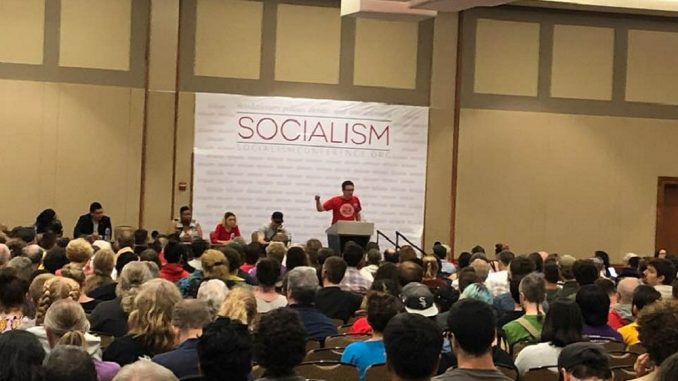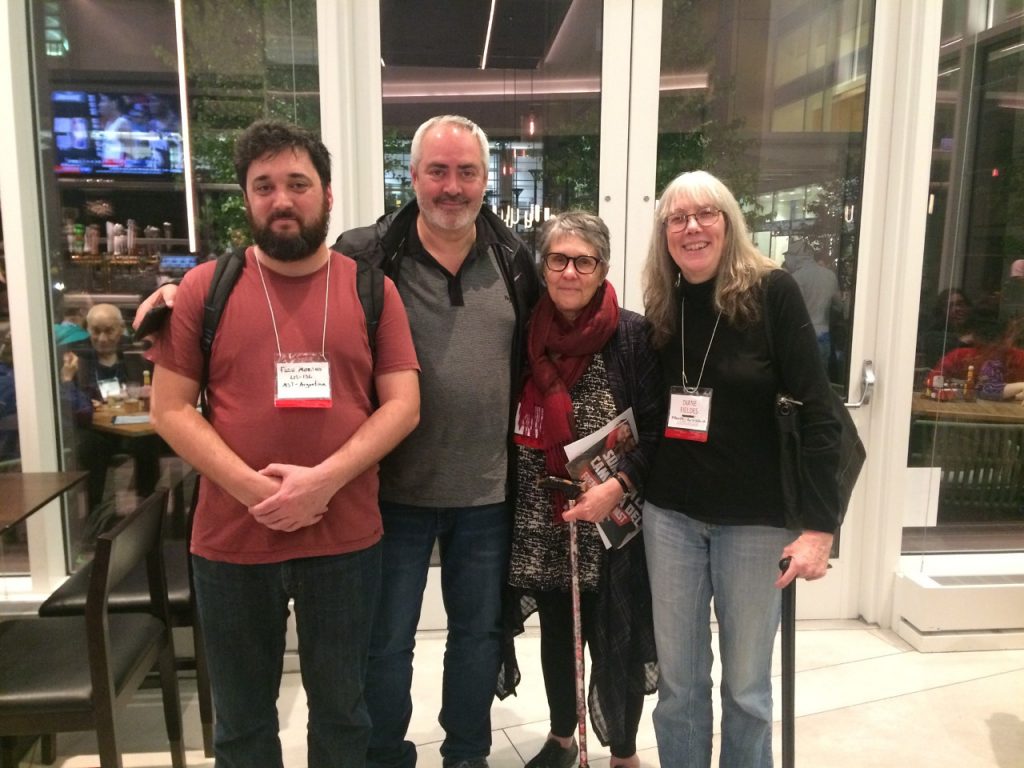
From July 4 to July 7 we attended the Socialism 2019 conference in Chicago. We then traveled to New York, where we met with other activists and leaders of the U.S. left. We socialize some of the debates, challenges and opportunities that revolutionaries are facing in the new socialist movement, which does not stop growing in the heart of imperialism.

Socialism is the main annual conference of the U.S. left. Despite the recent dissolution of the International Socialist Organization (ISO), which had organized the event for years, it gathered more than a thousand activists from across the country and delegations from various countries around the world. Our participation allowed us to know in greater depth the social and political process that the country is going through and to meet with activists from different sectors and organizations of the United States and other countries.
A new socialist movement
Trump’s reactionary policy has deepened the social polarization that has developed since the outbreak of the capitalist crisis in 2008 in the United States and powered the radicalization of a sector, especially in the youth. Bernie Sanders’ contention for the Democratic nomination in 2016 gave political expression to this radicalization, which originated in the social processes of Occupy Wall Street, Black Lives Matter, Me Too and the waves of teacher strikes in recent years.
After the Sanders campaign, came the election of Alexandra Ocasio-Cortéz to the House of Representatives, Julia Salazar to the New York state Senate and six socialist councilors in Chicago, among others, in addition to Trotskyist Kshama Sawant, who had been elected councilor in Seattle in 2014. The new presidential campaign of Bernie 2020 has once again mobilized tens of thousands throughout the country.
These electoral triumphs of candidates who call themselves socialists, reflect the emergence of a new socialist movement in the United States. The Economist published a cover story last year about what it dubbed “millennial socialism,” in which it warned that more than half of young Americans have a better image of socialism than of capitalism. Although the level of consciousness of this movement is still dominated by confused notions about socialism, it is undeniable that a political change of historical magnitude has taken place in the country.
Organizationally, this movement has been expressed in the rise of the Democratic Socialists of America (DSA), an organization that had a handful of members and militants when it joined the Bernie 2016 campaign, and today has become a power of some 5,000 active activists and 60,000 members who collaborate in varying degrees. Diverse interpretations of socialism, orientations and political currents coexist within the DSA. A reformist and electoral perspective is predominant, but it contains a swath of radicalized young people who are linked to social movements, and a fluid and dynamic internal discussion.
The return of Kautsky?
There is a debate in the U.S. left that reflects this dispute between reformist and more radical sectors. The first seek to recycle the thesis of the old reformist leader of German social democracy, who held that in bourgeois democracies the strategy to achieve socialism is the conquest of government through elections.
They argue that the insurrectionary road that triumphed in Russia in 1917 was only possible because it was against an autocratic State, and that it has been a historic mistake of the left to attempt to transfer that model to countries with bourgeois-democratic regimes, in which the state enjoys widespread legitimacy among workers.
The new Kautskyists, however, omit some fundamental issues. First, that the legitimacy of the state in bourgeois democracies quickly vanishes during the inevitable acute crises that capitalism plunges into. And when this happens, if a revolution does not triumph, it is often fascism that destroys parliamentary democracy and takes power. The experience of electoral socialism in Chilean with Salvador Allende and its tragic ending at the hands of Pinochet, is an example among many of where these old ideas lead. Today, though not reaching that outcome, what prevails in the world is the crisis of democratic regimes, polarization and the strengthening of alternatives to the left and the right that express the rejection of the political establishment.
Second, that while the electoral path to socialism, so many times recycled, has not given us a single example of an anti-capitalist advance, insurrectionary revolutions – albeit led by non-revolutionary bureaucratic leaderships that prevented them from advancing towards true socialism – expropriated the bourgeoisie in a third of the world.
Finally, when revolutionary crises occur, a strong revolutionary organization is indispensable for the revolution to triumph. For the purposes of the Kautskyists electoral path, broad socialist organizations like the DSA suffice. For a revolutionary perspective, however, though it may be correct to participate in broad organizations at certain times, what revolutionaries can never abandon is the strategic task of maintaining and building their own organization.
The dissolution of the ISO and the future of the revolutionary left
The Socialism conference was organized for years by the ISO, one of the main U.S. Trotskyist organizations in recent decades. Last year’s conference was crossed by that organization´s debate about how to respond to the monumental political change that shakes the country and how to relate to the DSA and the socialist movement in general from its historical position against supporting candidates who run on the Democratic ballot line.
Tragically, the refusal of the old leadership to adjust political tactics to better intervene in the new socialist movement that emerged outside the ISO, and the use of bureaucratic methods that prevented a fraternal debate, caused a crisis and an abrupt leadership changeover that, combined with the report of a case of sexual abuse mishandled by the previous leadership, led to the demoralization of the membership and the dissolution of the group in April. This year’s conference was organized by Haymarket, Jacobin and the DSA.
Hundreds of ex ISO militants met at the conference to discuss their next steps. Most of them continue to intervene in the social and political struggles and movements in their cities; Many of them have joined the DSA.
The central debate they are processing is how to organize in the following period: Should revolutionaries assimilate to the DSA? Should they reorganize a group that is opposed in principle to participate in the DSA and any campaign on the Democratic ballot? Should they rebuild a revolutionary organization with greater tactical flexibility?
In the International Socialist League, we believe that, beyond the tactical debate on how to relate to the DSA and the socialist movement or how to intervene in electoral processes, it is essential for comrades from the ex-ISO, from other revolutionary organizations or not from any, to find a way for revolutionaries to build their own organization in the United States. The possibility of facing challenges, seizing opportunities and offering a revolutionary solution to the debacle of capitalism in the next period will depend on this. Our intention in the LIS is to help in this strategic task.
Alejandro Bodart and Federico Moreno








